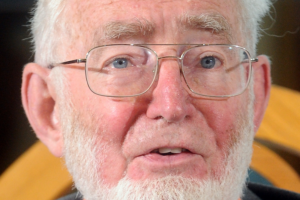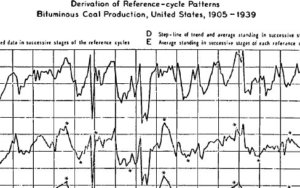I’ve already blogged on how undergraduate education evolved at MIT in the postwar era here and here, but since Mike Konczal and Paul Krugman make the case that, to bring introductory economics closer to the real world, macro should be taught before micro as Samuelson did in the first 13 editions of his Economics textbook, it may be worth returning to it.
Although Samuelson had published his own account on producing Foundations, still little is known about the process whereby he wrote and regularly revised Economics. Recent research has highlighted the importance of situating Samuelson’s endeavor both within the engineering context of MIT, and within the controversies surrounding Keynesian economics in the late forties and early fifties (and ongoing research carried out by Roger Backhouse may very soon shed full light on the making of the best-selling textbook).
Although Samuelson had a broader audience in mind, he wrote his textbook for non-economic students – most engineering and students at MIT were required to take introductory economics since at least 1945, but it is only in 1965 that a econ undergraduate program was opened –. Upon its 1948 release, Economics immediately became the basis for the two “Principle of Economics” introductory courses taught at MIT, with the consequence that students first went through a macro course (covering notions of scarcity, national income accounting, income determination, unemployment, economic growth, inflation and international economic problems), before turning to micro ( consumer theory, the theory of firms, equilibria, capital theory and micro policies). What may be of interest for today’s dicussions on teaching economics for the real world is that economists at MIT reversed such practice much earlier than Samuelson did and for altogether different reasons than those he invoked in the preface to his 1992 14 thedition (see Konczal’s post edit: given that the book was coauthored with Nordhaus and that McGraw Hill editors had significant influence on some changes between editions, it is not clear whether the preface quotes mentionned by Konczal can be attributed to Samuelson). As I have told elsewhere, it was the wave of students’ discontent and their demand for greater relevance from 1968 onward which prompted Peter Temin to suggest, in 1974, that micro should precede macro:
The new course will be oriented toward economic problems of current interest – such as the ‘energy crisis,’ pollution, and inflation – and problemes will be integrated into the teaching of the course…microeconomics (the study of particular industries and markets) will precede marcoeconomics (the study of the economy as a whole). This will serve to introduce the student to economics through the consideration of problems whose nature is most readily apparent to the non-economist and which are of professional interest to many engineers. In addition, a knowledge of microeconomics provides a necessary foundation for the study of macroeconomics ..
Proposed Course Outlines: 14.01 Microeconomics
Supply and demand curves: the energy ‘crisis’
Demand curves and consumer behavior
the theory of the firm: alternatue anti-pollution policies
Competitive markets: current problems of agriculture
Monopoly and Oligopoly: government regulation in the energy sector
Factor prices and income distribution
The role of government in microeconomic activity
Hence is how he curiculum evolved between the fifties and seventies at MIT:
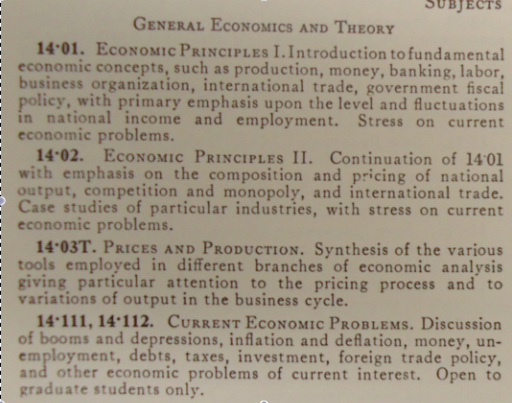
1952
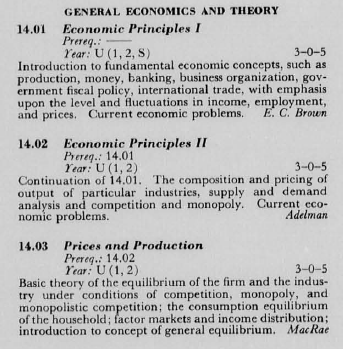
1965

1973, just before change
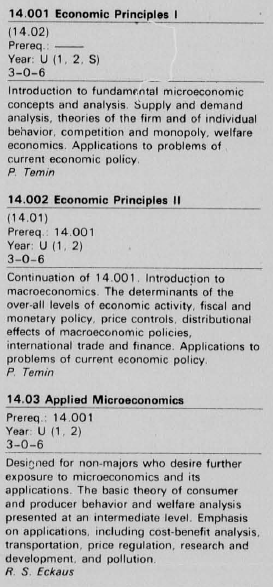
1976, after change
No celebration of markets, perfect competition or abstract and decontextualized reasoning is thus to be read in this decision to teach micro first, but a growing concern with microfoundations and a willingness to make economics relevant to the burning issues of the day that strikingly echoes present soul searching. Now, the question is to whether the diametrically opposed reorganizations of introductory economics envisionned then and now reflect differences in the characteristics of the crises or differences in the state of the discipline.
In 1952, Ralph Freeman, then head of the department of economics at MIT, vindicated the new and much challenged macro-oriented stucture of Samuelson’s textbook and MIT introductory courses by appealing to the Great Depression, new data, new techniques, and the need to make economics relevant:
“we have tried to keep up with the increasing mass of quantitative data becoming available and to keep abreast of improvements in analytical techniques and of shifts in emphasis resulting from changing economic conditions.
An interesting exemple of such a shift is to be found in the treatment of unemployment…. A great deal of what (economists) wrote and taught was based on the assumption of full employment…In recent years the economist’s enquiry has focussed on economic fluctuations. Unemployment of resources has thus become a major problem for investigation along with a study of changes in the level of prices. Because ups and downs in employment and periods of inflation and deflation are associated with changes in income available to purchase goods and services, the spotlight has ben turned on income analysis. The study of national income has been stimulated by the publication of improved statistics emanating chiefly from the federal government and by the development of new and better techniques of analysis.
I do not mean to imply that the traditional subjects have been abandonned. The economist is still trying to explain what the economic system is and how it operates. He is still concerned with the role of prices and profits in organizing economic activity and with the functions of money and market in assigning labor and capital to their more productive uses. What has happened is a reorientation of these traditional inquiries around the problems of income, employment and price levels. This new approach seems to have brought the study of economics nearer to the daily lives and people and closer to the problems with whih business men are most vitally concerned.”
In 1973, in the face of environmental, energy, urban and race crises, and stagflation, it seemed that a newly emerging applied microeconomics had the right tools to understand agents’ individual decisions and to design corrective tax schemes and incentives of all kinds to alter these behaviors.
Today, debates on the crisis and its remedies center on incentives and frictions in the financial sector, monetary policy, liquidity traps, debt and austerity, etc. An incentive to sell economics to freshmen with macro first? But what macromodels do macroeconomists have to offer to underwrite the choice between policy option? Is there any consensus on modeling and policy to be taught?
The rich history of the MIT “Principles of Economics” and other introductory courses (such as Friedman’s long-lived “Price Theory” course at Chicago) also suggests that many more dimensions could be taken into account when rethinking introductory economics. The postwar records exhibit heated and recurring discussions on:
- the content of the course: more/less theoretical analysis (suggested in 1968)? More/less empirical material (under debate in 1968-1974)? More/less history of economics? More/less analysis of existing institutions (“It is necessary for the teacher to spend a good deal of time describing the facts of economic life,” Freeman warned in 1952. “The traditional way….is through the examination of historical ideas…..a different approach is suggested here. Through a sophisticated look at current economic concepts and problems, the student’s appreciation of his surroundings should be enhanced,” Temin argued in 1974. It’s about time to bring back economic history and HET back into the curiculum, manysay today)
- the design of course material such as:
- readings to be included (a response to the attacks on Samuelson’s textbook was the design of a collection of readings “that includes extracts from economics writings of all sorts, ranging from Karl Marx to the National Association of Manufacturers,” Freeman announced; see Giraud for an exhaustive story. In the sixties and seventies, readings from The Public Interest, Public Policy, Challenge, classics such as Adam Smith, Economics reports to the President… )
- assignements (problem sets were introduced in the sixties as a mix between manipulation of models and short essays; generalized after the Temin report to “provide practivce in the use of economics to analyze particular questions,” and sometimes perceived as routine, technical and abstract exercices today)
- the type of final exams given (I have posted some exams questions from Samuelson, Friedman and Marschak here.The INET-funded research of Irwin Collier may soon provide an exhaustive set of examples at various institutions). Exams themselves reflect…
- .. .what is seen as underlying purpose of such introductory course


